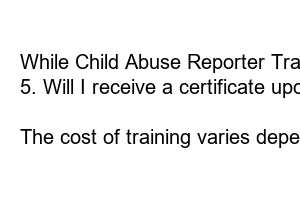아동학대 신고의무자 교육
Title: Child Abuse Reporter Training: Creating a Safe Environment for our Children
Introduction:
Child abuse is a deeply concerning issue that affects countless children worldwide. To effectively combat this issue, it is crucial to equip individuals with the necessary skills to detect and report child abuse cases promptly. Child Abuse Reporter Training serves as a vital resource that empowers individuals to protect children from harm. In this blog post, we explore the importance of child abuse reporter training, its benefits, and the ways it enables us to create a safer environment for our children.
1. What is Child Abuse Reporter Training?
Child Abuse Reporter Training is an educational program that educates individuals on how to identify signs of child abuse and appropriately report suspected cases. This training equips participants with the knowledge, confidence, and legal guidelines necessary to make a difference in the lives of vulnerable children.
2. The Importance of Early Detection:
By providing individuals with the tools to recognize the signs of child abuse, reporter training plays a crucial role in preventing further harm. Early detection allows for timely intervention and enables professionals to protect children from ongoing abuse.
3. Building Confidence:
Child abuse reporter training not only enhances knowledge but also builds confidence in individuals to take action when concerned about a child’s safety. The training offers practical scenarios, expert guidance, and best practices to ensure reporters feel empowered and supported throughout their reporting process.
4. Understanding Legal Responsibilities:
Child abuse reporter training educates individuals on their legal responsibilities in reporting child abuse cases. Participants gain insights into their roles as mandated reporters and learn about the legal framework that governs child protection. By understanding their obligations, individuals can work within the system to protect children effectively.
5. Breaking Down Barriers:
Child abuse reporter training addresses common barriers that often prevent individuals from reporting potential abuse. It encourages open communication, emphasizes the importance of confidentiality, and dispels myths or misconceptions surrounding reporting processes. Overcoming these barriers is essential to ensure more abused children receive the help they need.
6. Collaboration and Support:
Child abuse reporter training emphasizes the importance of collaboration among professionals, such as teachers, healthcare workers, and social service providers. By fostering a multidisciplinary approach, training helps create a network of support to effectively address child abuse cases and ensure comprehensive intervention and support for affected children.
7. The Impact of Child Abuse Reporter Training:
Child abuse reporter training plays a vital role in creating a safer environment for our children. It equips individuals with the knowledge and confidence needed to identify and report child abuse promptly. By working together, we can break the cycle of abuse, protect our children, and create a society where every child can thrive.
Summary:
Child Abuse Reporter Training empowers individuals to detect signs of child abuse and take appropriate action. Through early detection, building confidence, understanding legal responsibilities, breaking down barriers, fostering collaboration, and providing a network of support, this training is crucial in creating a safe environment for our children. By educating ourselves and working together, we can protect vulnerable children from the devastating effects of child abuse.
FAQs:
1. Who can undergo Child Abuse Reporter Training?
Child Abuse Reporter Training is suitable for individuals working with children, including teachers, healthcare professionals, social workers, and community members concerned about child welfare.
2. How long does the training typically last?
The duration of Child Abuse Reporter Training varies, but it generally ranges from a few hours to a full-day workshop.
3. Is Child Abuse Reporter Training available online?
Yes, many organizations offer virtual training programs that can be accessed conveniently from anywhere.
4. Can individuals report anonymously after receiving the training?
While Child Abuse Reporter Training encourages open reporting, some jurisdictions may allow anonymous reporting based on specific circumstances.
5. Will I receive a certificate upon completion of the training?
Most reputable training providers offer participants a certificate of completion, validating their knowledge and skills in identifying and reporting child abuse.
6. How much does Child Abuse Reporter Training cost?
The cost of training varies depending on the provider, location, and format (in-person or online). Many organizations offer free or subsidized training to promote widespread participation.

